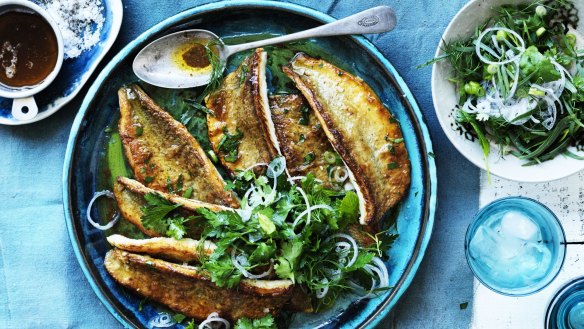The secret to perfectly crisp-skinned fish without the mess

How do I stop fish from sticking to the pan, and get crisp skin? P. Galbally
We spoke to chef Nick Mahlook from the Atlantic in Melbourne. He grew in the fishing village of Lakes Entrance in Gippsland cooking fresh fish in the family seafood restaurant. He reckons you'll need a good pan, heat and some fat to cook the fish in. Olive oil is good but he uses ghee as the smoke point is higher and it crisps the skin without burning. You'll also need a flexible fish spatula. Make sure the fish is dry. Any moisture that comes from the fish in the first seconds of cooking will reduce the heat and stop the crust from forming. Any protein in that moisture will bond with the surface of the pan at a molecular level and cause it to stick. Heat the fat. Season the fish and place the fish in the pan, skin side down. Mahlook says, "Holding the fish down with a spatula and using a weight is a good method. Different pressures and times should be used for different fish – the trick is to apply enough pressure for enough time to set the protein together so the fish won't spring back up." Don't try to flip the fish until the skin naturally loosens itself from the pan. If you use a meat thermometer, allow the internal temperature to reach 52C for medium rare. Remove and allow to rest. "Another method we use in the restaurant with certain cuts of fish," he says, "is the 'cold fish, cold pan' method, which allows the fish to gradually heat up with the pan then relax to a nice flat surface as the skin crusts up. This is best practised with thicker cuts of fish."
I am planning my Passover menu and I want to do some lighter dishes this year. E. Berger
I had neighbours who were Sephardic Jews. They were descended from the Jews expelled from Spain in the late 1400s by Queen Isabella and King Ferdinand. This family ended up living in Libya until they came to Australia. A lot of their dishes were a blend of Spanish and Jewish cooking – chopped tuna or white fish melded with breadcrumbs and cooked in a lemon sauce. After meeting them I read British Egyptian Jewish author Claudia Roden's book on the history of Spanish food in which she claims the Iberian Peninsula's cuisine is almost all founded on Jewish cooking. "Apart from the jamon," she joked. My neighbours also cooked a lot of North African dishes such as hand-rolled couscous with lots of spices and vegetables. May I suggest you hunt out a book called The Passover Gourmet by Nira Rousso, first published in 1987. I found my copy online. Rousso scoured New York collecting recipes from Jews who had arrived from all around the world, compiling an encyclopaedia of Passover recipes. Among them are dishes such as caponata from Sicily, lemon veal with artichokes from Rome, Chinese chicken omelette from Harbin, China, fava bean soup from Tunisia and pineapple and horseradish salad from who knows where. The book is somewhat dated but it's really interesting for ideas.
Letters
Recently we mentioned that to make meatballs hold together the mince needed to be massaged. One reader, J. Laurie, wrote, "Well may we say 'knead the mince' but nothing will save a meatball without a lightly beaten egg – or if you don't do eggs, a bit of flaxseed soaked in hot water." Thank you. We also were talking about the need for a good wooden spoon. B. Hayes replied with, "I'm almost 80 and still use the wooden spoon my mother used all through my childhood and although it's still good, it has worn away slightly on one side. Some years ago, my nephew, now 65, brought a wooden spoon to the breakfast table and when his mother asked him why, his immediate response was: 'I think I'm going to be naughty!'"
Send your vexing culinary conundrums to brainfood@richardcornish.com.au or tweet to @realbrainfood.
Appears in these collections
More:
From our partners
Original URL: https://www.smh.com.au/goodfood/the-secret-to-perfectly-crispskinned-fish-without-the-mess-20190304-h1bz5e.html
